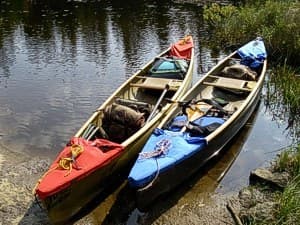Custom Canoe Care Tips
My friend Bob Brown once eyed my four impeccably maintained solo canoes and suggested that I was really a yachtsman at heart. "Canoes should show some battle scars," said Bob: "Shows you're a canoeist not a canoer!"

In the event you disagree, here are some custom touches that will keep your canoe looking like a work of art.
OIL YOUR BRIGHTWORK! Oiled wood rails are easier to maintain and more flexible (less likely to break) than varnished ones. On rigorously maintained canoes, one type of finishing oil works as well as another, though a tougher finish often results when high-gloss linseed and tung oil formulations are used on top of deep penetrating marine oils. Here's how to get a rich, furniture grade shine:
- Strip away the factory varnish. Then, remove dents and gouges by "whiskering" the wood with a hot iron.
Procedure: Saturate a cotton rag with water and ring it dry. Fold the damp rag several times and set it over the dent. "Iron" the cloth until it no longer steams. This will raise the grain and remove the dent.
- Sand (80-120 grit) the bare wood to a soft patina then stain to darken the color if you wish.
- Apply oil to the wood with a lint-free rag. Wipe off the excess oil when you've finished coating the wood. Lightly polish the wood with the cloth as you work. Leave the canoe right-side-up, trim exposed to the sun for an hour or two, before you store it away.
- Repeat step 3 as often as you like. In a few weeks, the wood grain will fill and take on a deep, rich look.
- After every dozen or so applications, cut the oil to the surface of the wood with 000 steel wool soaked with Watco oil. Then, repeat step 3.
RESTORE WEATHERED WOODWORK
To restore gray, weathered woodwork, sand well then apply trisodium phosphate (TSP) cleaner, available at hardware stores. Work in the TSP with a stiff brush and wear protective gloves. Rinse completely, allow to dry, then sand to silky smoothness. Afterwards, apply a quality finishing oil in successive coats as suggested above.
REMOVE STAINS AND SCUM
Occasionally use a commercial hull cleaner (I've had good results with Star brite) to remove scum lines and stains from fiberglass and Kevlar™ gel-coat. Canoe retailers often wipe on a coat of Lemon Pledge™ before they display their canoes in the store. 303 Protectant will hide scratches and give the gel-coat a slick new look.
FOR ROYALEX CANOES
Your Royalex canoe will last as long as you if you store it out of the sun and occasionally apply an ultraviolet protectant (I recommend 303 Protectant) to the hull and plastic rails. Abrasive damage to the vinyl and ABS is easily repaired with epoxy and fiberglass.
Procedure:
Sand off the vinyl (epoxy won't stick to it) around the damaged area then epoxy on two or more fiberglass patches. Sand the cured patches smooth and paint to match the hull. This should last through the canoeing season. Yes, thick Kevlar skid plates offer more protection than fiberglass, but they are heavy, ugly and they slow down the canoe. We-no-nah Canoe company factory-applied "invisible/integral" patches are the proud exception.
FOR ALUMINUM CANOES
Flat black paint will cut glare off the decks of aluminum canoes and give these craft a custom look. Prime the metal with vinegar before you paint. Allow the vinegar to set overnight so it will have time to etch the aluminum.
Your aluminum canoe will slide over rocks more quietly if you apply a heavy coat of auto paste wax to the hull. For a custom touch, replace the dull aluminum thwarts and yoke with brightly varnished wood. Pre-cut canoe parts are available at most canoe shops.
Well maintained, high quality canoes appreciate over time. Ill kept, low grade craft do the opposite. Thoughtful maintenance goes a long way towards maintaining the value of your investment.
Cliff Jacobson is a professional canoe guide and outfitter for the Science Museum of Minnesota, a wilderness canoeing consultant, and the author of more than a dozen top-selling books on camping and canoeing. Visit his website at: www.cliffcanoe.com
Related Articles
In this video, the team at Austin Kayak show you how to rebuild your keel if you have created a hole…
In this video, Chad Hoover shows you how to quickly fix the hull of your fishing kayak. All you need is…
I remember the anticipation of the spring thaw when I could finally get out on the water again after a…
"The major difference between a thing that might go wrong and a thing that cannot possibly go wrong is…



